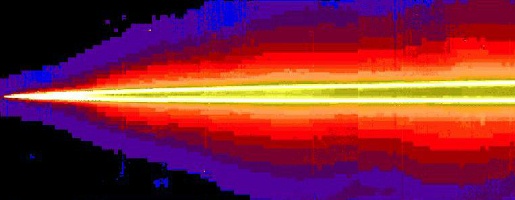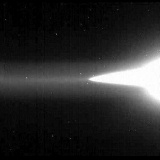 |
|||||||||||||||||||||||||||||||
|
False
colour view of Jupiter's main ring and surrounding halo.
|
|||||||||||||||||||||||||||||||
| THE RINGS OF JUPITER | |||||||||||||||||||||||||||||||
| All four of the gas giants possess ring systems. Those of Jupiter, like Neptune's and Uranus', are faint and difficult to see. | |||||||||||||||||||||||||||||||
| Jupiter's main ring was discovered in 1979 in a Voyager 1 image intended specifically to capture any rings if present. When it was found that Jupiter did indeed possess a ring, the imaging schedule was redesigned to obtain more pictures. It was later found that Jupiter had not just one ring but its own modest ring system. It is, however, far less distinctive and far less complex than Saturn's ring system. The Galileo mission has obtained additional images of Jupiter's rings, revealing structure in the system that was previously unknown. The images here are derived from Galileo data. The Galileo spacecraft also has a dust collector, and has been able to actually sample the rings. | |||||||||||||||||||||||||||||||
| Structure | |||||||||||||||||||||||||||||||
| The ring system consists of three main elements. They are the main ring, the halo, and the gossamer ring. All the rings are very diffuse, and made up of very fine dust particles. | |||||||||||||||||||||||||||||||
 Mosaic of the components of Jupiter's ring system. |
 Map of Jupiter's ring system and inner moons. |
||||||||||||||||||||||||||||||
|
|||||||||||||||||||||||||||||||
| Main ring | |||||||||||||||||||||||||||||||
| The main ring is 6400 kilometres wide but less than 30 kilometres thick. It is the brightest of Jupiter's rings. The main ring has sharp edges and is enclosed by the orbits of Jupiter's innermost moons, Adrastea and Metis. These "shepherd" moons keep it the ring in place. | |||||||||||||||||||||||||||||||
 Jupiter's main ring. |
 Jupiter's main ring and Jupiter's limb. |
||||||||||||||||||||||||||||||
| Halo ring | |||||||||||||||||||||||||||||||
| The inner edge of the main ring grades into the halo. It is a thick ring or torus of very fine material which begins 1000 kilometres above Jupiter's clouds. It is thought to be composed of particles from the main ring which are pulled inwards by Jupiter's gravity. | |||||||||||||||||||||||||||||||
| Gossamer rings | |||||||||||||||||||||||||||||||
| Outside the main ring is another very faint ring called the gossamer ring. Galileo images revealed that there are in fact two rings, one embedded in the other. They are the Amalthea gossamer and the Thebe gossamer. | |||||||||||||||||||||||||||||||
| The Amalthea gossamer is the innermost of the two, it extends from Adrastea (130,000 kilometres from Jupiter) to Amalthea (181,000 kilometres). The Thebe gossamer stretches from Amalthea to Thebe (221,000 kilometres). | |||||||||||||||||||||||||||||||
 The inner edge of the faint Amalthea gossamer ring. |
|||||||||||||||||||||||||||||||
| The two faint gossamer rings are fairly uniform. They are extremely tenuous - indeed, they are more transparent than window glass. The Thebe gossamer is just slightly fainter than the Amalthea gossamer. | |||||||||||||||||||||||||||||||
| Origin of the rings | |||||||||||||||||||||||||||||||
| A meteoroid impacting on a Jovian moon will bury itself under the surface, vaporise, and then explode, blowing off debris and dust particles. | |||||||||||||||||||||||||||||||
| Some of the dust will slowly fall back onto the moon's surface - such layers of dust can be seen on Callisto's surface, for example. Other dust particles, however, will escape from the moon's low gravity but will remain in Jupiter's orbit, trapped by Jupiter's stronger gravitational field. These are the particles that make up Jupiter's ring system. | |||||||||||||||||||||||||||||||
 Cross-section through Jupiter's ring system. |
|||||||||||||||||||||||||||||||
| It is not a coincidence that the gossamer rings are aligned with the orbits of Thebe and Amalthea, for Thebe and Amalthea are the source of the rings. Another indication comes from colour - Amalthea is a dark, red moon, and the gossamer rings are composed of dark, red, particles. Furthermore, the orbital inclination of Amalthea, and the wobble of Amalthea's orbit, means that the vertical thickness of the Amalthea gossamer ring extends to the maximum vertical position that Amalthea can occupy. Thebe's orbital inclination is greater than Amalthea's, its maximum vertical position is higher above Jupiter's equatorial plane, and the Thebe gossamer ring is therefore deeper than the Amalthea gossamer ring. | |||||||||||||||||||||||||||||||
| The orbital inclinations of Adrastea and Metis are lower than those of Amalthea and Thebe, and so the rings they have created and maintain should not be as deep. This is exactly what is observed. | |||||||||||||||||||||||||||||||
| If the rings are formed by meteoritic impact on the surfaces of the inner Jovian moons, surely there should be further rings extending out to the other, bigger moons ? However, it is precisely because the other moons are more massive that they cannot form ring systems. Io, for example, is over 10,000 times more massive than tiny Amalthea. The greater the mass of a moon, the higher its escape velocity - ejected debris from an impact merely falls back to the moon's surface, and does not enter into an orbit around Jupiter. Nevertheless, material from Io's volcanoes may be involved in the formation of the rings. | |||||||||||||||||||||||||||||||
| Ring destruction | |||||||||||||||||||||||||||||||
| The particles in the rings have very short lifetimes, probably less than 1000 years. Various forces cause them to spiral inwards towards Jupiter. As they approach Jupiter, the powerful magnetic field starts to take over from gravity and influence the particle motion. The particle orbits start to increase inclination, and this explains why the inner halo is the deepest. Eventually, the magnetic field dominates gravity entirely, and when this happens the particles are very quickly pulled out of the ring plane, dragged along the magnetic field lines of force, and dumped into Jupiter's atmosphere. | |||||||||||||||||||||||||||||||
| As the particles are slowly spiralling towards the inner halo, and the inner halo is being continuously destroyed, meteoritic bombardment must be a process that is continuing today. | |||||||||||||||||||||||||||||||
|
|
|||||||||||||||||||||||||||||||